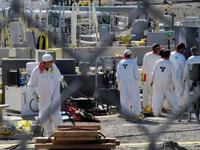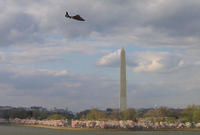-
Fukushima-derived radioactivity in seafood poses minimal health risks
Researchers find that the likely doses of radioactivity ingested by humans consuming fish contaminated by radioactive radiation escaping from the debilitated Fukushima reactors fish, are comparable to, or less than, the radiological dosages associated with other commonly consumed foods, many medical treatments, air travel, and other background sources.
-
-
Health impact of Chernobyl accident overestimated: study

The impact of the Chernobyl nuclear accident has been seriously overestimated, while unfounded statements presented as scientific facts have been used to strangle the nuclear industry, according to Russian researchers.
-
-
Pennsylvania emergency professionals receive WMD training
The Center for Domestic Preparedness (CDP) in Alabama hosted more than a hundred emergency professionals from the Pennsylvania South Central Mountains Regional Task Force’s Health and Medical Committee for in-depth response-to-WMD training.
-
-
Energy Department to invest in used nuclear fuel storage research
As part of its efforts to develop an effective strategy for the safe and secure storage and management of used nuclear fuel, the Energy Department the other day announced a new dry storage research and development project. In the Energy Department’s budget request presented last week, the department requested $60 million for nuclear waste research and development.
-
-
New radioactive waste repackaging facility in Los Alamos
The Los Alamos National Laboratory has brought a third waste repackaging facility online to increase its capability to process nuclear waste for permanent disposal. The box line facility is largest of its kind ever built.
-
-
June workshop on approaches to CBRNE incidents
NIST-organized workshop will explore ways to improve an all-of-government approach that increases resilience to international chemical, biological, radiological, nuclear, or explosive (CBRNE) incidents.
-
-
Radioactive leaks at Washington’s Hanford nuclear reservation

Earlier this month, Washington Governor Jay Inslee announced that a radioactive waste tank at one of the nation’s most contaminated nuclear sites is leaking, bringing more bad news to Washington’s Hanford nuclear reservation. The 177 tanks at the plant, which hold millions of gallons of highly radioactive waste from plutonium production, are way past their intended 20-year life span.
-
-
Defusing the threat of ionizing radiation
The damage to Japan’s Fukushima nuclear reactor after the 2011 Tohoku earthquake raised concerns regarding U.S. preparedness to treat large-scale human exposure to ionizing radiation. Additionally, the immediate destructive potential of nuclear and radiological weapons, as well as their long-term health and economic impacts, continue to be of concern to DoD. Researchers look for novel approaches to mitigate immediate and long-term health damage from acute exposure to ionizing radiation and model its biophysical effects.
-
-
Thorium holds promise of safer, cleaner nuclear power
Thorium as nuclear fuels has drawbacks, but its main advantage includes generating far less toxic residue. The majority of the mineral is used during the fission process, and it can burn existing stockpiles of plutonium and hazardous waste, saving the need to transport it and bury the waste in concrete. If thorium becomes available as a source of energy in the future, the world will rely less on coal and gas, and wind turbines will become a thing of the past. The risk of a global energy crunch will decrease considerably.
-
-
U.K. revises nuke emergency plans post-Fukushima
The Sizewell nuclear power station in Suffolk, England, was decommissioned in 2006, but after the 2011 Fukushima disaster, the Suffolk authorities thought there was a need to upgrade the emergency plans for the people living around the plant. There are disagreements, however, over the radius of the emergency zone around the plant, and how many people should be included i evacuation plans and given potassium iodide tablets in the event of a radiation leak.
-
-
Tiny helpers: Atom-thick flakes help clean up radioactive waste, fracking sites

Graphene oxide has a remarkable ability quickly to remove radioactive material from contaminated water. Researchers determined that microscopic, atom-thick flakes of graphene oxide bind quickly to natural and human-made radionuclides and condense them into solids. The discovery could be a boon in the cleanup of contaminated sites like the Fukushima nuclear plants, and it could also cut the cost of hydraulic fracturing (“fracking”) for oil and gas recovery and help reboot American mining of rare earth metals.
-
-
Airborne pods tracing nuclear bomb’s origins
If a nuclear device were to unexpectedly detonate anywhere on Earth, the ensuing effort to find out who made the weapon probably would be led by aircraft rapidly collecting airborne radioactive particles for analysis; relatively inexpensive UAVs, equipped with radiation sensors and specialized debris-samplers, could fly right down the throat of telltale radiation over a broad range of altitudes without exposing a human crew to hazards
-
-
Helicopter monitors radiation levels in Washington, D.C.

For the last week, a National Nuclear Security Administration (NNSA) helicopter has been flying over Washington, D.C., measuring naturally occurring radiation levels; the purpose is to establish a baseline of radiation levels so that abnormal spikes – occurring, for example, as a result of exploding a dirty bomb — may be readily detected
-
-
U.S. cuts budget for nuclear monitoring at foreign ports
In 2003 the United States decided to install radiation detection equipment in 100 large ports around the world, and train local personnel in using the equipment, so that ship containers could be scanned for nuclear material before the ship left for the United States; so far, equipment has been deployed in forty-two ports; after GAO criticism of the quality of the scanning equipment and of lack of coordination between two similar container scanning programs, the National Nuclear Security Administration’s 2013 budget will be cut by 85 percent, and further installations will be canceled
-
-
New, quick way to ID people exposed to dirty bomb, radioactive radiation
Research conducted by scientists from the Berkeley Lab could lead to a blood test that detects if a person has been exposed to radiation, measures their dose, and separates people suffering from inflammation injuries — all in a matter of hours
-
- All
- Regional
- Water
- Biometrics
- Borders/Immig
- Business
- Cybersecurity
- Detection
- Disasters
- Government
- Infrastructure
- International
- Public health
- Public Safety
- Communication interoperabillity
- Emergency services
- Emergency medical services
- Fire
- First response
- IEDs
- Law Enforcement
- Law Enforcement Technology
- Military technology
- Nonlethal weapons
- Nuclear weapons
- Personal protection equipment
- Police
- Notification /alert systems
- Situational awareness
- Weapons systems
- Sci-Tech
- Sector Reports
- Surveillance
- Transportation
Advertising & Marketing: advertise@newswirepubs.com
Editorial: editor@newswirepubs.com
General: info@newswirepubs.com
2010-2011 © News Wire Publications, LLC News Wire Publications, LLC
220 Old Country Road | Suite 200 | Mineola | New York | 11501
Permissions and Policies
Editorial: editor@newswirepubs.com
General: info@newswirepubs.com
2010-2011 © News Wire Publications, LLC News Wire Publications, LLC
220 Old Country Road | Suite 200 | Mineola | New York | 11501
Permissions and Policies
